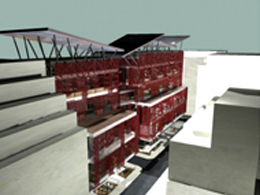STUDENTS PROJECTS
PROJECTS 2011

13 May, 2012
Art space in Thessaloniki
This project concerns an art-centre situated in the historical centre of Thessaloniki, at the junction of the Victor Hugo- and Fragon- street.
Student: Sarlani Chrysavgi
Supervisors: K.Tsoukala, C.Conenna
Consultants: P.Lazaridis, V.Vasiliadis, M.Voyatzaki, S.Lefaki
AUTH faculty of architecture
Date : 24 June 2011

The site is defined by Egnatia-, Tsimiski-, Ionos Dragoumi- and Dodekanisou- streets. The particular ground is also of historical importance since there has been a successful excavation. This multifunctional space is equipped with a number of art-laboratories, a library, an exhibition space, a film projection room and a small restaurant-cafe. The project aims to contribute in the development of the sited area; which is nowadays characterized by commercial- and office-buildings, as well as "night-life" oriented businesses. The integration of the building in the city is achieved through simple and clearly defined forms, which perfectly accumulate to the already existing facades of the surroundings.
The building is distinguished by the introduction of a wired mesh overlapping its glazing surfaces. Relying on the external viewpoint, the construction consists of two volumes connected with bridges on the third and fourth floor; which permits the figure to be conceived as one building. The composition is based on a metal structure (core). The visibility of this core structure is obtained by the presence of two external layers. The first layer-a glass veil-, adds a feeling of lightness and transparency, while the second layer- a wired mesh creates an illusion of constant kinesis. The combination of glass and metal reveals an aesthetic of materials which is apt to be modern.
A bioclimatic approach is revealed by means of these two skin facades. Although glass tends to contribute to the overheating of inner-spaces, natural ventilation is achieved through sidewise openings of the glazing surface; whereas the second skin offers a changeable shading system. The wired metal surface is divided so that the shading panels are folded and unfolded according to the sun exposure and orientation of the building.
One of the main concerns was to preserve and make visible the findings of the excavation. The remains were found in a depth of five meters below the ground level and it is estimated that most of the findings belong to the paleochristian, meso-and hysteron-byzantine period. There are also indications of ceramo-plastic activity.
Metal and glass surfaces above the findings were designed, creating routes that allow the visitor to observe and interact with the revealed ruins. The accessibility of the excavation is achieved through staircases that lead the visitor from the ground floor on a glass level just two meters above it. Accessibility serves the purpose of projecting the historical importance of the site and at the same the proposed static system is explicitly designed to respect the fragile archaeological environment.
Each of the two volumes carries an identical structural system that consists of two static elements. This static elements support a metal beam that is almost as high as a floor itself. The static element (4x6 m) is actually a construction of interlacing vertical and diagonal columns (intersection: 15cm) which embody the vertical communication. The engineering tubes are also included.
This structure establishes in plan a succession of flowing spaces in each floor that allow the organization of flexible art areas. The spatial structure of each floor is organised by portable free standing wall panels. A terrace at the third floor creates an outdoor corridor during the summer months. The ground floor is formed by a playful combination of fullness and void. A pedestrian glass zone at the back of the building offers a pleasant walk and serves as a source of light in the underground level. Finally, the independent, inclined planes of the roof make the facade more emphatic compared to the firm optics of the external volume of the building.


















